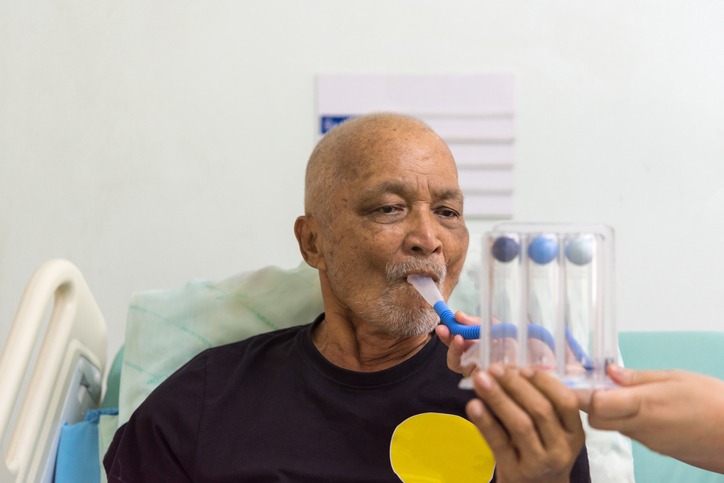For better lung function, consider using an incentive spirometer as a deep breathing exercise. Set some objectives with the assistance of your healthcare practitioner. Using an incentive spirometer regularly will help you build stronger lungs. Your doctor or healthcare team will also instruct you on how to operate the device safely and effectively.
What is an incentive spirometer?
Simple and made of plastic, an incentive spirometer (spy-rom-uh-ter) helps you exercise your lungs. After a chest or abdominal injury, sickness, or surgery, your doctor may advise you to use an incentive spirometer.
Incentive spirometers are used to remove mucus and other secretions from the chest and lungs, increase lung capacity, build lung strength, and maintain lung inflation, all of which are beneficial in warding off lung infections. The oxygen levels in your blood may drop after surgery or a major illness, but with the aid of an incentive spirometer, you can get them back up to normal.
Who needs to use an incentive spirometer?
Incentives for using a spirometer to build lung strength have received mixed reviews from researchers at Trusted Source.
The fact that it keeps the lungs working during bed rest suggests, however, that it may be useful for those recovering from surgery.
Atelectasis, pneumonia, bronchospasms, and respiratory failure are among conditions that can be avoided with regular spirometer use.
The following conditions may also benefit from using an incentive spirometer:
- Rib fractures can result in serious consequences to the lungs, including pneumothorax, lung contusion, and death. Research Using an incentive spirometer has been shown by a reliable source to improve lung function and lessen the risk of these problems.
- People with pneumonia often utilize incentive spirometry to help clear up the phlegm that has settled in their lungs.
- COPD stands for chronic bronchitis (COPD). Chronic obstructive pulmonary disease (COPD) is a collection of symptoms and signs related to breathing problems. Smoking cessation, a spirometer, and regular exercise can help reduce symptoms, but there is yet no cure.
- People with cystic fibrosis may find that utilizing an incentive spirometer helps them eliminate fluid accumulation. Spirometry has been shown in a 2015 study using reliable sources to have the ability to decrease intrathoracic pressure and the risk of central airway collapse.
- Sickle cell anemia, asthma, MS, and atelectasis are some of the additional illnesses for which an incentive spirometer may be recommended by a doctor.
Why is an incentive spirometer helpful, exactly?
A breathing exerciser spirometer works the lungs similarly to a cardio machine. It’s useful for keeping your lungs in good shape, or for rehabilitating them after an illness or injury.
Using an incentive spirometer after surgery can…
- Allow more air into the lungs. The term “ventilation” refers to the amount of air that enters and exits the lungs with each breath.
- Rapidly recover from the effects of anesthesia. An incentive spirometer is used to assist in the expulsion of anesthetic from the lungs.
- Helps break up mucus in the lungs. Constant, deep exhalations can keep your lungs clear of excess fluid and mucus.
- Facilitate the avoidance of lung problems. Inhaling slowly and deeply will fully expand your lungs, removing fluid that may otherwise cause lung illnesses like pneumonia.
When should I use an incentive spirometer and how do I use it?
The correct way to use an incentive spirometer is to:
- If you can, pull up a chair to the side of your bed. The least you can do is to sit up as far as you can in bed.
- Put the incentive spirometer on a flat surface and hold it upright.
- You should insert the mouthpiece into your mouth and close your lips around it to make a tight seal.
- It’s important to take deep, steady breaths. You can see the yellow piston climbing the column. The blue circle represents where the yellow piston has to go.
- Try to go as long as you can without breathing, at least five seconds. Take a deep breath out and let the piston gently descend to the base of the column.
- After a brief break, do the first five steps at least ten times for every hour you’re awake.
- Get your best breath on record by lining up the yellow indicator on the side of your incentive spirometer. Take deep, steady breaths while aiming at the indicator.
- In between each round of 10 breaths, give a good, hard cough to help flush the lungs. When coughing, if you have a surgical incision, place a pillow or rolled-up cloth against it for support.
- After you feel well enough to get out of bed, go for regular short walks and give your cough a workout. Unless otherwise directed by your doctor, you can discontinue using the incentive spirometer as soon as you are able to move around.
- Do not continue using an incentive spirometer if you have any symptoms of dizziness.
Why and when you should see a doctor
When using a spirometer, you could feel faint or dizzy. Stop what you’re doing and take a few deep breaths if you feel dizzy. Make an appointment with your doctor if the symptoms continue.
If you find that you can’t reach your objective or that deep breathing causes you discomfort, you should probably make an appointment with your doctor. Damage to the lungs may result from excessive use of an incentive spirometer.
Conclusion
When used regularly, a breathing exercise spirometer may be an effective tool for enhancing respiratory health.
Upon discharge from the hospital following surgery, your doctor may provide you with a spirometer to monitor your recovery at home. Those who suffer from lung disorders like COPD may also benefit from using an incentive spirometer to maintain lung function and prevent fluid buildup.
Good pulmonary hygiene, such as utilizing an incentive spirometer, can help you expel mucus and other fluids from your lungs.
